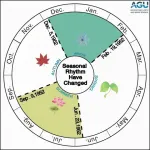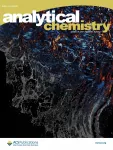(Press-News.org) WASHINGTON--Without efforts to mitigate climate change, summers spanning nearly six months may become the new normal by 2100 in the Northern Hemisphere, according to a new study. The change would likely have far-reaching impacts on agriculture, human health and the environment, according to the study authors.
In the 1950s in the Northern Hemisphere, the four seasons arrived in a predictable and fairly even pattern. But climate change is now driving dramatic and irregular changes to the length and start dates of the seasons, which may become more extreme in the future under a business-as-usual climate scenario.
"Summers are getting longer and hotter while winters shorter and warmer due to global warming," said Yuping Guan, a physical oceanographer at the State Key Laboratory of Tropical Oceanography, South China Sea Institute of Oceanology, Chinese Academy of Sciences, and lead author of the new study in Geophysical Research Letters, AGU's journal for high-impact, short-format reports with immediate implications spanning all Earth and space sciences.
Guan was inspired to investigate changes to the seasonal cycle while mentoring an undergraduate student, co-author Jiamin Wang. "More often, I read some unseasonable weather reports, for example, false spring, or May snow, and the like," Guan said.
The researchers used historical daily climate data from 1952 to 2011 to measure changes in the four seasons' length and onset in the Northern Hemisphere. They defined the start of summer as the onset of temperatures in the hottest 25% during that time period, while winter began with temperatures in the coldest 25%. Next, the team used established climate change models to predict how seasons will shift in the future.
The new study found that, on average, summer grew from 78 to 95 days between 1952 to 2011, while winter shrank from 76 to 73 days. Spring and autumn also contracted from 124 to 115 days, and 87 to 82 days, respectively. Accordingly, spring and summer began earlier, while autumn and winter started later. The Mediterranean region and the Tibetan Plateau experienced the greatest changes to their seasonal cycles.
If these trends continue without any effort to mitigate climate change, the researchers predict that by 2100, winter will last less than two months, and the transitional spring and autumn seasons will shrink further as well.
"Numerous studies have already shown that the changing seasons cause significant environmental and health risks," Guan said. For example, birds are shifting their migration patterns and plants are emerging and flowering at different times. These phenological changes can create mismatches between animals and their food sources, disrupting ecological communities.
Seasonal changes can also wreak havoc on agriculture, especially when false springs or late snowstorms damage budding plants. And with longer growing seasons, humans will breathe in more allergy-causing pollen, and disease-carrying mosquitoes can expand their range northward.
Going to extremes
This shift in the seasons may result in more severe weather events, said Congwen Zhu, a monsoon researcher at the State Key Laboratory of Severe Weather and Institute of Climate System, Chinese Academy of Meteorological Sciences, Beijing, who was not involved in the new study.
"A hotter and longer summer will suffer more frequent and intensified high-temperature events - heatwaves and wildfires," Zhu said. Additionally, warmer, shorter winters may cause instability that leads to cold surges and winter storms, much like the recent snowstorms in Texas and Israel, he said.
"This is a good overarching starting point for understanding the implications of seasonal change," said Scott Sheridan, a climate scientist at Kent State University who was not part of the new study.
It is difficult to conceptualize a 2- or 5-degree average temperature increase, he said, but "I think realizing that these changes will force potentially dramatic shifts in seasons probably has a much greater impact on how you perceive what climate change is doing."
INFORMATION:
AGU supports 130,000 enthusiasts to experts worldwide in Earth and space sciences. Through broad and inclusive partnerships, we advance discovery and solution science that accelerate knowledge and create solutions that are ethical, unbiased and respectful of communities and their values. Our programs include serving as a scholarly publisher, convening virtual and in-person events and providing career support. We live our values in everything we do, such as our net zero energy renovated building in Washington, D.C. and our Ethics and Equity Center, which fosters a diverse and inclusive geoscience community to ensure responsible conduct.
Notes for Journalists
This research study is freely available through 15 April. Download a PDF copy of the paper here. Neither the paper nor this press release is under embargo.
This press release and accompanying images are available online at:
https://news.agu.org/press-release/northern-hemisphere-summers-may-last-nearly-half-the-year-by-2100/
Contact information for the researchers:
Yuping Guan,
South China Sea Institute of Oceanology,
guan@scsio.ac.cn
(GMT+8)
Paper title:
"Changing Lengths of the Four Seasons by Global Warming"
Authors:
Jiamin Wang: Key Laboratory for Semi-Arid Climate Change of the Ministry of Education, College of Atmospheric Sciences, Lanzhou University, Lanzhou, China; State Key Laboratory of Tropical Oceanography, South China Sea Institute of Oceanology, Chinese Academy of Sciences, Guangzhou, China; College of Marine Sciences, University of Chinese Academy Sciences, Beijing, China
Yuping Guan: State Key Laboratory of Tropical Oceanography, South China Sea Institute of Oceanology, Chinese Academy of Sciences, Guangzhou, China; College of Marine Sciences, University of Chinese Academy Sciences, Beijing, China
Lixin Wu: Physical Oceanography Laboratory/Institute for Advanced Ocean Study, Ocean University of China, Qingdao, China; Pilot National Laboratory for Marine Science and Technology, Qingdao, China
Xiaodan Guan, Jianping Huang: Key Laboratory for Semi-Arid Climate Change of the Ministry of Education, College of Atmospheric Sciences, Lanzhou University, Lanzhou, China
Wenju Cai: Physical Oceanography Laboratory/Institute for Advanced Ocean Study, Ocean University of China, Qingdao, China; Pilot National Laboratory for Marine Science and Technology, Qingdao, China; Centre for Southern Hemisphere Oceans Research, CSIRO Oceans and Atmosphere, Hobart, Tasmania, Australia
Wenjie Dong: School of Atmospheric Sciences, Sun Yat-Sen University, Zhuhai, China; Key Laboratory of Tropical Atmosphere-Ocean System, Ministry of Education, Zhuhai, China; Southern Marine Science and Engineering Guangdong Laboratory, Zhuhai, China
Banglin Zhang: Guangzhou Institute of Tropical and Marine Meteorology/Guangdong Provincial Key Laboratory of Regional Numerical Weather Prediction, CMA, Guangzhou, China.
Nursing homes with the largest proportions of non-White residents experience 3.3 times more COVID-19 deaths than do nursing homes with the largest proportions of White residents, according to a new study from the University of Chicago. The paper, published in JAMA Network Open, suggests that these differences are likely due to nursing home size and the level of coronavirus spread in the local community, reinforcing the inseparability of long-term care facilities from society at large when it comes to bringing the COVID-19 pandemic to heel.
Since the start of the ...
Traumatic brain injury (TBI) is a major cause of disability and a risk factor for early-onset dementia. The injury is characterized by a physical insult followed acutely by complement driven neuroinflammation. Complement, a part of the innate immune system that functions both in the brain and throughout the body, enhances the body's ability to fight pathogens, promote inflammation and clear damaged cells. Complement plays a role in the brain, regardless of infection or injury, as it influences brain development and synapse formation. In TBI, complement- induced inflammation partially determines the outcome in the weeks immediately following injury. However, more research is needed to define a role for the complement system in neurodegeneration ...
For cancer cells to metastasize, they must first break free of a tumor's own defenses. Most tumors are sheathed in a protective "basement" membrane -- a thin, pliable film that holds cancer cells in place as they grow and divide. Before spreading to other parts of the body, the cells must breach the basement membrane, a material that itself has been tricky for scientists to characterize.
Now MIT engineers have probed the basement membrane of breast cancer tumors and found that the seemingly delicate coating is as tough as plastic wrap, yet surprisingly elastic like a party balloon, able to inflate to twice its original size.
But while a balloon becomes much easier to blow up after some initial effort, the team found that a basement membrane becomes stiffer as it expands. ...
Found around the world, powdery mildew is a fungal disease especially harmful to plants within the sunflower family. Like most invasive pathogens, powdery mildew is understudied and learning how it affects hosts can help growers make more informed decisions and protect their crops.
Scientists at the University of Washington and the University of Central Florida inoculated 126 species of plants in the sunflower family with powdery mildew, growing 500 plants from seeds that were collected from the wild and provided from the USDA germplasm network. Through this ...
BOSTON - The higher rates of obesity in Black, Indigenous and People of Color (BIPOC) compared with other groups in the United States can be attributed in large part to systemic racism, according to a new perspective article published in the Journal of Internal Medicine. The authors offer a 10-point strategy to study and solve the public health issues responsible for this disparity.
"First, it is important to recognize that the interplay of obesity and racism is real. Once persons recognize this, they can begin to appropriately address and treat obesity in BIPOC communities," says co-author Fatima Cody ...
Women who experienced hypertensive disorders of pregnancy (HDPs) but did not develop chronic hypertension have a greater risk of premature mortality, specifically cardiovascular disease (CVD)-related deaths, according to a study published in the Journal of the American College of Cardiology (JACC). A separate JACC study examined the cardiovascular health risks associated with pregnancy in obese women with heart disease.
HDPs, which occur in approximately 10% of all pregnancies worldwide, are among the most common health issues during pregnancy. There are four types of HDPs: chronic hypertension, gestational hypertension (GHTN), preeclampsia and ...
Other senses re-routed during evolution, but not sense of smell
Loss of smell linked to depression and poor quality of life
Smell research can help treatments for loss in COVID-19
CHICAGO ---Odors evoke powerful memories, an experience enshrined in literature by Marcel Proust and his beloved madeleine.
A new Northwestern Medicine paper is the first to identify a neural basis for how the brain enables odors to so powerfully elicit those memories. The paper shows unique connectivity between the hippocampus--the seat of memory in the brain--and olfactory areas in humans.
This new research suggests a neurobiological basis for privileged access by olfaction to memory areas in the brain. The study compares connections between primary sensory areas--including ...
Researchers have developed a spectroscopic microscope to enable optical measurements of molecular conformations and orientations in biological samples. The novel measurement technique allows researchers to image biological samples at the microscopic level more quickly and accurately.
The new instrument is based on the discrete frequency infrared spectroscopic imaging technique developed by researchers at the Beckman Institute for Advanced Science and Technology at the University of Illinois Urbana-Champaign.
"This project is about bringing the study ...
DALLAS - March 8, 2021 - A study led by UT Southwestern and Children's Health researchers defines parameters for the number of white blood cells that must be present in children's urine at different concentrations to suggest a urinary tract infection (UTI). The findings, published recently in Pediatrics, could help speed treatment of this common condition and prevent potentially lifelong complications.
UTIs account for up to 7 percent of fevers in children up to 24 months old and are a common driver of hospital emergency room visits. However, says study leader Shahid Nadeem, M.D., assistant professor of pediatrics at UTSW as well as an emergency department physician and pediatric nephrologist at Children's Medical Center Dallas, these bacterial infections ...
Boston, MA - Financial pollution arises when exorbitant or unnecessary healthcare spending depletes resources needed for the wellbeing of the population. This is the subject of a JAMA Health Forum Insight co-authored by researchers in the Department of Population Medicine at Harvard Pilgrim Health Care Institute and Harvard Medical School. The Insight was published in the March 8, 2021 issue of JAMA Health Forum.
The authors lay out the rationale for "financial pollution" as a metaphor to express the urgency of addressing wasteful health care spending and to guide innovative policymaking. Akin to environmental pollution, financial ...





